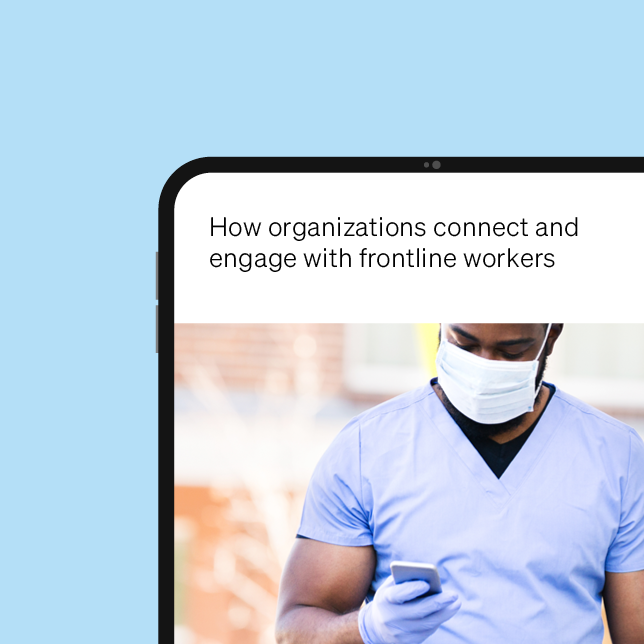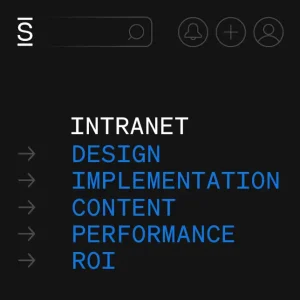Today, many companies consist of a combination of “office” and “frontline” workers. But it’s incredibly common for decision-making in any company to be directed by, and focused on, those in the office, with little to no involvement from the frontline. However, today leading organizations are recognizing the need to include everyone and create a cohesive and engaging employee experience that speaks to the entire workforce.
Adapting to the fourth industrial revolution
A variety of industries, including manufacturing, retail, construction, healthcare, transportation, agriculture, hospitality, and education, have tech stacks that traditionally lag behind the rest of society. And these industries make up the bulk of the significant frontline workforce that exists today. In fact, we find ourselves in the midst of the fourth industrial revolution (Industry 4.0), with 80% of the total workforce being frontline.
Companies are racing to adopt, embrace, and evolve with the changing workforce and its needs by taking stock of existing pain points to address operational challenges and potential disruptions that new technology might bring. The world is digitally transforming, and companies caught unprepared are now experiencing the consequences.
Check out our blog to learn how to use internal comms for a successful digital transformation
Companies need intuitive IT options requiring clicks, not code
Lacking advanced IT options, companies require ways to quickly and intuitively unify their communications, people, and workplace—and do so with clicks, not code. In addition, they need solutions that are easy to implement and maintain—things that do not add extra work to overburdened IT departments.
Modern organizations recognize the need to include everyone and create a cohesive and engaging employee experience for the entire workforce. With a rising generation of tech-savvy workers, mounting external pressures, and enterprise-level computing advances, organizations have the proper motivation to realize the goal.
Millennials increasingly form the majority of frontline workers and neither understand nor want to work with dated systems like cloud-based ERPs. This may seem like advanced technology by the industries’ traditional standards, but it just isn’t. That’s the challenge for companies.
Solution providers that seek to help these organizations face a different challenge: They have to understand what works but also have an intimate understanding of the complex needs of these organizations and their existing pain points. This is crucial because addressing operational challenges is only one side of the coin, as there are also potential disruptions that new technology brings.
And this all needs to happen relatively quickly, as workers are leaving jobs where they feel unsupported in droves.
Connecting with employees to improve retention rates
The biggest challenge for many organizations today includes attracting and retaining their frontline workforce. People are, on average,25% more likely to quit their jobs today than before 2019. Moreover, most of those who leave their jobs (65%) do not return to the same industry.
In fact, aBCG study found that 1 in 3 frontline workers will likely quit within the next six months. More recently, in itsbiannual Job Optimism survey, “of more than 2,500 professionals in the U.S., 46% of respondents are currently looking or plan to look for a new role in the first half of 2023, up from 41% just six months ago.”
Organizations are more likely than ever to lose their employees, and the cost of replacing and reskilling them has also gone up as the learning curve continues to climb. So as they map their digital adoption, companies must contend with these challenges and design systems that address the root causes
In our guide, we speak to the many reasons why workers leave their current jobs and ways to connect with this chronically detached and distributed workforce.
Connecting with a distributed workforce
For many companies, this is the first time they are thinking seriously about the employee experience—especially for the frontline worker. They have thousands of employees across multiple locations, and their workforce is disparate and diverse, with varying language capabilities and tech-savviness.
The modern organization needs to position itself at the very center of these siloed spaces and rethink the physical separation of plants or locations so that it doesn’t affect performance, well-being, and sense of belonging. Companies must ensure every employee, both office and frontline, know they all share the same common mission and goals.
But how?
What are most companies missing, and what is at stake for failing to implement effective employee experience programs for frontline workers, specifically? We have answers and case studies from companies like yours that have transitioned from technologically outdated to employee experience pros with a workforce that is digitally and globally aligned.
Download and read How companies can connect and engage frontline workers to learn more. And reach out for a demo of some options that will help you create an employee experience that works specifically for your organization!

















